Umbrellabird (original) (raw)
Umbrellabirds have an umbrella-like crest on the top of their heads (for which they were named) and a tube-shaped inflatable pouch on their throats. They are the largest species of perching bird (Passerine) in South America, but populations are currently decreasing because of habitat loss.
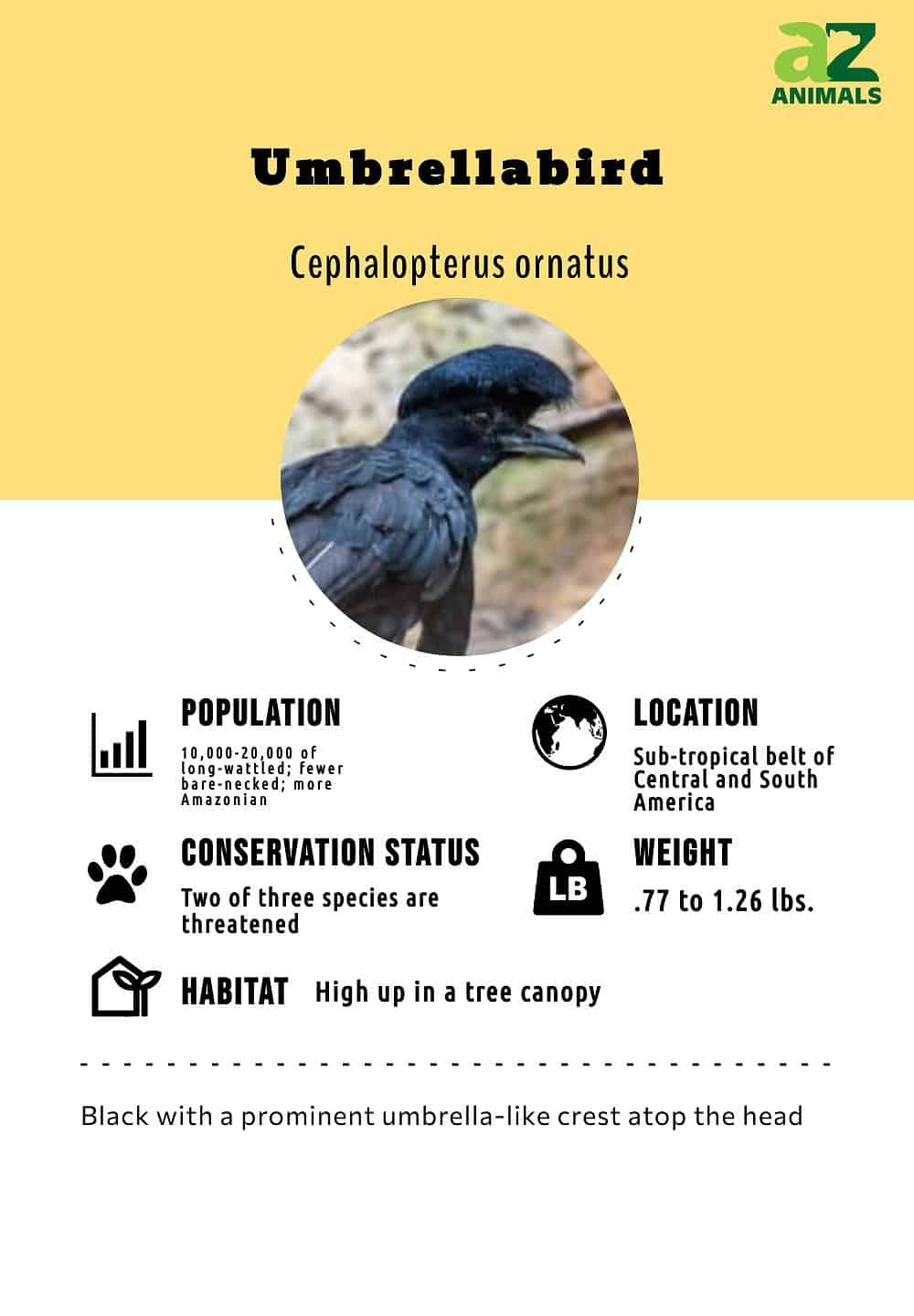
Classification and Evolution
The Umbrellabird is a large, tropical species of bird that is found inhabiting the rainforests of Central and South America. It is a cotinga, a member of the family Cotingidae, order Passeriformes. There are three different species of the genus Cephalopterus, all of which live in slightly different areas but are similar in appearance:
- Amazonian (or Ornate) Umbrellabird (C. ornatus) – Amazon basin
- Long-Wattled Umbrellabird, (C. penduliger) – Ecuador and Colombia, west of the Andes
- Bare-Necked Umbrellabird (C. glabricollis) – Panama and Costa Rica
Some scientists think that the Long-Wattled and Bare-Necked Umbrellabirds are subspecies of the Amazonian Umbrellabird.
Anatomy and Appearance
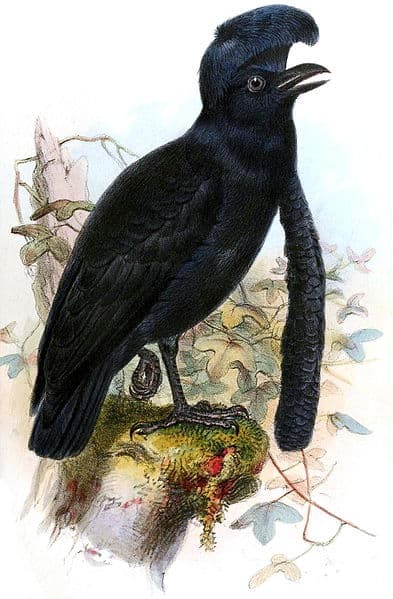
The Long-wattled Umbrellabird, Cephalopterus penduliger, has a wattle on its throat that can grow over 13 inches ong.
©Joseph Wolf (1820-1899) – Public Domain
The most distinctive feature of the Umbrellabird is the large crest on the top of its head. During mating, the males fan their crest out so that it nearly covers the whole of their head and they then begin to make rumbling sounds to attract a female. All three Umbrella bird species are similar in size and their bodies are covered in mostly black feathers. but each subspecies has unique features. The Long-Wattled Umbrellabird has a wattle on its throat that can grow over 13 inches long; the males of the Amazonian Umbrellabird are thought to be the largest of all three species; the Bare-Necked Umbrellabird is easily distinguished by the reddish, featherless patch of skin on its throat and the small, red wattle.
Distribution and Habitat
The Umbrellabird is found throughout the sub-tropical belt of Central and South America where they spend the majority of their time hopping between branches high up in the tree canopy. For most of the year, the Umbrellabird can be found inhabiting lowlands and mountain foothills, generally at altitudes less than 500 meters. During the breeding season however, they migrate higher into the mountains where the gather in groups known as a “Lek” where they can find a mate. These breeding sites are usually in cloud forests that are between 800-2,000 meters above sea level. The Umbrella bird is known as an altitudinal migrant as it migrates up and down the mountains rather than across the land.
Behavior and Lifestyle
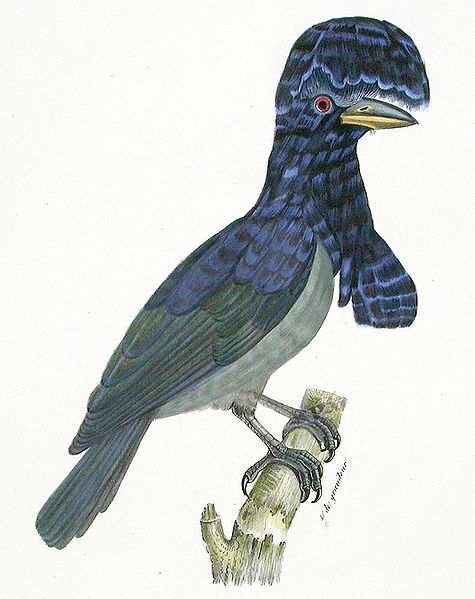
Cephalopterus ornatus, the Amazonian Umbrellabird, tends to hop from branch to branch, gripping with its clawed toes.
©Louis Pierre Vieillot (1748-1831) – Public Domain
The Umbrellabird is generally a solitary animal that is known to cohabitate areas with other Umbrellabirds and similar species such as Woodpeckers. Its large size makes flying more difficult compared to other species so it generally hops from branch to branch, gripping with its clawed toes. Although the Umbrellabird can fly short distances, it is relatively slow and clunky in the air. During the breeding season, however, these birds migrate to higher altitudes where they gather in small groups to choose a mate. Here the male performs courtship displays for the female to watch before she picks a partner.
Reproduction and Life Cycles
Mating territories are occupied from March until June. Once paired up, the female constructs a relatively large nest from twigs, moss, and leaves inside a tree that is often far from the ground. This is thought to be to protect the nest from hungry predators that feed on the eggs of the Umbrellabird. The female then lays a single egg which is incubated for only a month before it hatches, with the chick then being fed by its parents before it leaves the nest a couple of months later. Abandoned nests have been found alongside a current nest, indicating that females may even return to the same tree to lay their eggs every year. Umbrellabirds are thought to live for an average of 16 years in the wild.
Diet and Prey
Like many of the world’s tropical perching birds, the Umbrellabird is an omnivorous animal that feeds on what’s available in the tops of the trees. Fruits and small animals are the Umbrellabird’s primary sources of food. It eats a range of invertebrates such as insects and spiders, along with small frogs and birds. The Umbrellabird uses its strong toes to hold onto the branches while it picks fruits and berries with its curved beak. The quite long, black beak of the Umbrellabird is similar to that of a Raven and allows the Umbrellabird to snap up passing insects with ease. Since the Umbrellabird drops seeds from the fruit it eats across the forest, it plays a vital role in its native eco-system.
Predators and Threats
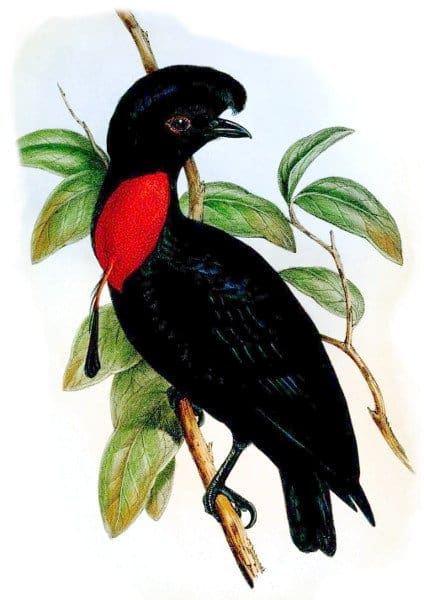
Tthe Bare-necked Umbrellabird, Cephalopterus glabricollis, like other umbrellabirds, is threatened by habitat loss.
©Lichter – Public Domain
The Umbrellabird spends the majority of its time at the tops of trees, so ground-dwelling predators pose little threat to this unique bird. Arboreal animals, however, are a different story, often preying on the eggs and younger individuals that are a more manageable size. Monkeys and snakes are the primary predators of the Umbrellabird, along with large birds of prey such as hawks and eagles that can hunt from the air. The biggest threat to the Umbrellabird, however, is humans, who clear their native lowland forests, generally for agriculture.
Although all three species are being severely affected by habitat loss, the Long-Wattled Umbrellabird is thought to be most under threat as it lives in only a handful of very specific areas.
Interesting Facts and Features
The distinctive throat pouch of the Umbrellabird inflates on the males during the breeding season. The reason for this, it is believed, is to make their rumbling calls louder, making a booming sound that is said to sound like a hippo. The wattle is one of the characteristics that differs the most among the three species of Umbrellabird. The Long-Wattled Umbrellabird has a long black wattle (as its name suggests), while the Amazonian’s is shorter, and the Bare-Necked Umbrellabird’s is red in colour and much smaller than the others.
The Umbrellabird’s existence was first recorded by Sir Alfred Wallace, a companion of Charles Darwin’s, in the 1800s while on an expedition to South America.
Relationship with Humans
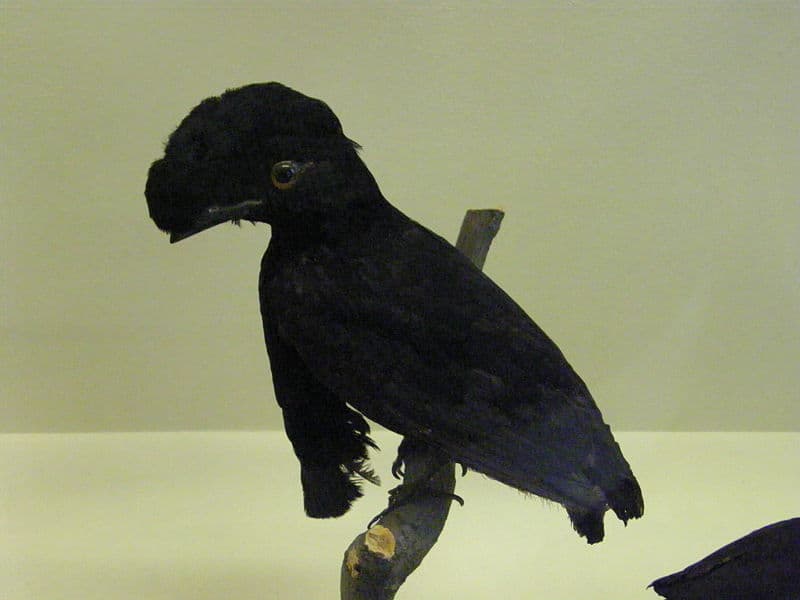
The Umbrellabird lives in the rainforest canopy and is rarely seen in open areas.
©frank wouters, CC BY 2.0, via Wikimedia Commons – Original / License
Because the Umbrellabird lives high in the rainforest canopy and is rarely seen in open areas, it can often be hard to spot during the non-breeding season when it is in the lowlands. Higher up in the mountain cloud forests, however, the breeding sites of the Umbrellabird have been known to be targeted by local hunters. It is the deforestation of the lowlands, where they spend most of their time, that has led to drastic declines in their population numbers. These areas are most commonly turned into pineapple and banana plantations that do not accommodate their arboreal lifestyle.
Conservation Status and Life Today
Today, the Long-Wattled Umbrellabird is listed as “Vulnerable” while the Bare-Necked Umbrellabird is considered to be “Endangered.” However, the Amazonian Umbrellabird has been classified by the IUCN as Least Concern. All three species are under threat, nonetheless, mainly due to the loss of significant chunks of their natural habitats, with most of the remaining populations now found in protected areas.
View all 23 animals that start with U
Umbrellabirds are Omnivores, meaning they eat both plants and other animals.
Umbrellabirds belong to the Kingdom Animalia.
Umbrellabirds belong to the phylum Chordata.
Umbrellabirds belong to the family Cotingidae.
Umbrellabirds belong to the order Passeriformes.
The biggest threat to the Umbrellabird is habitat loss.
The Umbrellabird has a wingspan of 66cm to 71cm (26in to 28in).
Umbrellabirds lay eggs.